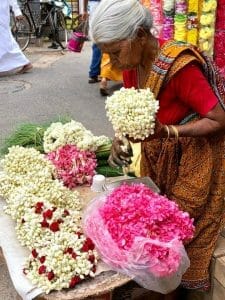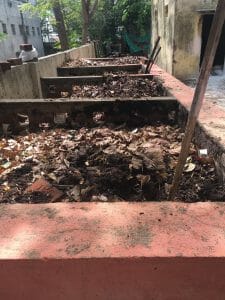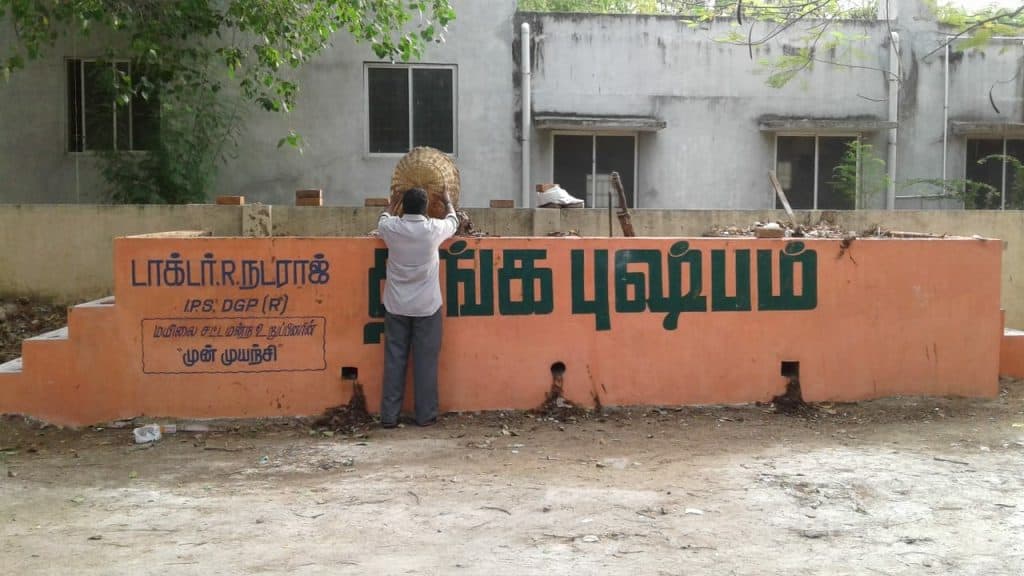Nature is the manifestation of God, said Frank Lloyd Wright, the noted American architect. Indeed, Nature is often equated with the divine. However, our worship of the divine often takes a toll on the natural environment.
Have we stopped to consider the magnitude of waste generated at our religious institutions? Tamil Nadu, which has 38,000 temples under the Hindu Religious and Charitable Endowments (HR &CE) department alone, generates more than 3.8 lakh kilos of floral waste every day, according to a senior HR & CE official. This number does not include the hundreds of private temples, mosques and gurudwaras, where flowers are widely used as offerings.
In order to encourage eco-friendly practices in temples, a few like minded individuals and organisations began experimenting with a twin strategy – composting of flowers and discouraging the use of plastics in temples of Chennai. Besides the environmental benefits, it makes economic sense too.
How waste can feed people
Sri Kapaleeswarar temple in Mylapore and Sri Ananthapadmanabha Swamy temple in Adyar were among the first to embrace green practices, as part of a Waste-to-Energy initiative. Exnora Green Pammal, an environmental organisation, partnered with ITC Limited to set up two biogas plants at the Kapaleeswarar temple in January 2017. Cow dung from the temple Goshala (cowshed) is the primary source for these biogas plants.
“The gas generated from the waste lights up the gas cylinders in the temple’s kitchen. It replaces eight cylinders, on an average, every month, bringing revenue from the refuse,” said Mangalam Balasubramaniam. The rich-in-nutrients slurry discharged from the biogas plants, combined with the flowers offered to the deities, are converted to manure through aerobic composting.
At the Padmanabha Swamy temple, big bins (aaga pots), with a capacity of 250 kilos, are used to compost the leftover food and flowers. The practise started in October 2017 and involved training the workers on waste segregation. The manure generated is donated to the devotees.
For a plastic-free divinity
Sri Rathnagireeswarar temple in Besant Nagar has become a plastic free zone, after an organisation called Namma Ooru Foundation (NOF) spearheaded the ‘Namma Green Temple project’ in early June 2018. It is a pilot project where NOF has introduced a sustainable ecosystem through smart waste management. Source segregation, wet waste composting within temple premises, disposal of recyclables, ban on plastic use within the temple, and ensuring zero food waste constitute the multi-pronged approach adopted by the organisation.
The 5 – 10 kilograms of flower waste generated from the temple everyday is aerobically composted, easing the load on the landfills. “We implemented a ban on styrofoam cups and plastic, with the help of the temple management. There is a collective motivation, as vendors and devotees replaced plastic with viable alternatives such as thayyal ilai and paper,” explained P Natarajan, founder of Namma Ooru Foundation. He thanked the temple management for supporting the cause, and added that devotees too have enthusiastically taken an oath to reduce plastic use in the temple.
While single use plastic is banned, there are a few plastic items that cannot be avoided, Natarajan says. “Oil bottles and milk sachets are given to recycling companies. NOF sees waste as a resource,” he added.
The first batch of floral compost is in process and will take two more weeks to be turned into manure. The team follows holistic principles of waste management by not just composting but also donating the left-over food.
“It is necessary to educate people about the positive effects. We will be part of the project for at least three months to stabilise and give end-to-end solutions,” added Natarajan.
Individual effort
A K Kannan, an employee of Doordarshan Chennai and Mylapore resident, collects flowers from 21 temples across Chennai and transfers them to composting units, which are dedicated to composting ‘Nirmalyam’- floral offerings to the gods. Kannan’s routine of the past six years, has spread positivity among many citizens, who have started composting flowers in their homes.
Asked how he started floral waste composting, he says, “I started composting at home. When the idea of replicating the same at temples came to me, I was so inspired. Floral waste adds to the landfills and clogs water bodies. By composting them, we can generate revenue.”
Kannan collects as much as 150kgs of flower waste everyday and transfers them to the compost bins in MRC Nagar, Alwarpet and MRTS Mandaveli. “The priests in the temples are helpful in segregating the waste. The manure is sold at Rs 40 to citizens,” Kannan adds.
A sustainable way
The concept of floral waste management is picking up momentum in Mylapore, which is a hub of temples, thanks to the support and encouragement received from Mylapore MLA R Nataraj. He has even christened it – Thanga Pushpagam.
The dynamics of floral waste differs from temple to temple. For example, floral and green waste is generated more in Anjaneya temples and less in a Saibaba temple for a simple cultural reason. “Flowers are given back to the devotees in Saibaba temples, but Thulasi (Holy basil) that is a primary offering in Anjaneya temples stays in temples and eventually goes to the corporation landfills,” said K Viswanathan, Secretary, Mylapore Residents Welfare Association.
The Corporation division office at C P Ramaswamy road in Alwarpet, which is now the office of the MLA, has four bins for processing floral waste. Six more bins were constructed on railway land near Mandaveli MRTS.
“Around 100 kilos of floral waste from six temples is collected in these bins every day. We also encourage citizens to drop their floral waste at the bins,” said Viswanathan, while he also thanked the MLA: “Dr Nataraj has played a huge role in the initiative. He allotted the bins at his office and also requested the railways to grant the land for more bins.”
In what may be seen as hope for the future, deliberations on similar initiatives are being reported from other parts of the country as well. Ayodhya for example, with almost 10,000 temples, produces 10 to 15 quintals of floral waste everyday. Talks are on to turn the withered flowers into traditional natural perfume. The Sai Baba temple in Mumbai has been converting the flower waste into perfumes, that is used for aroma therapy.
How can you compost flowers?
Small initiatives from citizens can be a blessing for the environment. Krishnan Iyer, a priest at an Amman temple in Ekkaduthangal, lays out a guide about composting techniques. The priest has been composting all the floral waste in the backyard of the temple, for five years now.
- Keep aside the floral waste from the other waste. Oil bottles and sachets should be separated from the floral waste.
- Prefer to buy loose flowers over the ones strung together as garlands, as the thread used has plastic. Tied flowers are tough to segregate.
- Replace plastic bags with ‘Donnai’ and ‘Thayyal Ilai’ to carry flowers.
- To compost flowers at your house, segregate the floral waste. Dust should also be removed.
- In houses with a backyard, residents can dig a pit and dump the flowers in it. Floral waste is odour free and can become compost in less than 45 days.
- Apartment dwellers can use khamba pots to compost the waste.



A divine initiative, thank and appreciate Mr. Kannan for his efforts. The guidelines given by Mr. Krishnan would be very helpful for trying it out at home level.